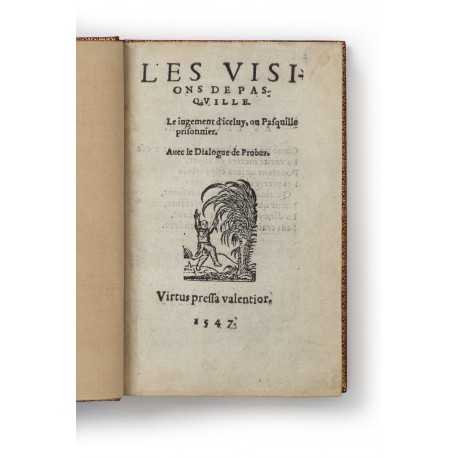 View larger
View larger
Les Visions de Pasquille. Le iugement d’iceluy, ou Pasquille prisonnier. Avec le Dialogue de Probus [and Lucius]
- Subjects
- Reformation in literature - Early works to 1800
- Authors/Creators
- Curione, Celio Secondo, 1503-1569
- Printers/Publishers
- Gérard, Jean, active 1536-1558
Curione, Celio Secondo
Ciriè nel Canavese (Turin) 1503 – 1569 Basel
Les Visions de Pasquille. Le iugement d’iceluy, ou Pasquille prisonnier. Avec le Dialogue de Probus [and Lucius].
[Geneva, Jean Girard with René de Bienassis], 1547
octavo (130 × 80 mm), (172) ff. signed a–x8 y4 and paginated 1–344. Printer’s device on title-page (a child with a palm frond, motto ‘Virtus pressa valentior’) associated with Jean Girard.1
provenance Zisska & Kistner, Auktion 19/i, Munich, 4 May 1992, lot 532 — Reiss & Sohn, Auktion 118, Königstein im Taunus, 22 April 2008, lot 741
Faint stain in corner of title and two following leaves, otherwise a well-preserved copy.
binding nineteenth-century red morocco, all edges gilt, signed Hardy (upper joint neatly repaired).
A French translation of Pasquino in estasi nuovo, a satirical dialogue between Pasquille and Marfoire in the manner of Lucian, celebrated for its attacks on the papacy and allusions to contemporaries and to contemporary events.
The author studied at Turin where he was converted to Lutheranism at the age of twenty. He taught at Turin, Milan, Pavia, and other North Italian towns, and was arrested and imprisoned by the Inquisition. (The ‘Dialogue de Probus’ appended here describes his escape in 1537 from an archiepiscopal prison.) In 1542 Curione fled to Lausanne and in 1547 moved to Basel, where he was given the chair of Latin eloquence. His bibliography includes numerous pedagogical treatises, commentaries on Cicero’s orations and rhetorical works, on Persius and Juvenal, and translations of Appian and Aeschines.
Curione allowed two versions of this work to circulate in manuscript for several years and apparently did not supervise the passage of either into print. In 1543 a German translation ‘auß Welscher Sprach’ of the second, larger version was published by Philip Ulhart at Augsburg.2 The next year both versions were printed in Latin at Basel and the second version was printed in Latin by Jean Girard at Geneva. Editions in Italian of both versions followed in 1545–1546. Our book published in 1547 is a French translation of the second Latin version. An English translation, entitled Pasquine in a Traunce, appeared in 1566.3

These copies are known to the writer
● Berlin, Staatsbibliothek zu Berlin – Preußischer Kulturbesitz, Dg 1156 ● Cambridge, ma, Harvard University, *IC5 C9263 Eh547v ● Edinburgh, National Library of Scotland, Newb.1544 ● Geneva, Bibliothèque publique et universitaire, Bc 2930 Rés.5 ● Grenoble, Bibliothèque municipale, F.16776 (‘Le titre manque’) ● Lincoln, uk, Lincoln Cathedral Library6 ● London, British Library, 3901.a.34 ● Los Angeles, University of Southern California, Clark Library, PQ4621.C9 P28F 1547* ● Lunel (Hérault), Bibliothèque municipale, LUL 77 ● Madrid, Biblioteca Nacional, U 1784 ● Neuchâtel, Bibliothèque publique et universitaire, past. 106.57 ● Paris, Bibliothèque nationale de France, D2-34748 ● Paris, Bibliothèque nationale de France, Arsenal, 8° BL-19357 ● Vienna, Österreichische Nationalbibliothek, BE 8.5.39 ● Wroclaw, Biblioteka Uniwersytecka, 455.472
references Markus Kutter, Celio Secondo Curione: Sein Leben und sein Werk (Basel & Stuttgart 1955), pp.102–109, 285 no. 6; Index Aureliensis: Catalogus librorum sedecimo saeculo impressorum (Baden-Baden 1996), xi, 148.574
1. Paul Heitz, Genfer Buchdrucker- und Verlegerzeichen (Strasbourg 1908), no. 21; Ugo Rozzo, ‘Editori e tipografi italiani operanti all’estero “religionis causa” in La stampa in Italia nel Cinquecento. Atti del convegno, Roma, 17–21 Ottobre 1989, edited by Marco Santoro (Roma 1992), i, p.94.
2. Verzeichnis der im deutschen Sprachbereich erschienenen drucke des xvi. Jahrhunderts (Stuttgart 1985), C–6432.
3. Letizia Panizza, ‘Pasquino among Anglican Reformers: the two editions in English (1566 and 1584) of Celio Secondo Curione’s Pasquino in estasi’ in Ex Marmore. Pasquini, pasquinisti, pasquinate nell’Europa moderna, Atti del Colloquio internazionale Lecce-Otranto, 17–19 November, 2005, edited by Chrysa Damianaki, Paolo Procaccioli and Angelo Romano (Rome 2006), pp.407–428.
4. National Library of Scotland, A short-title catalogue of foreign books printed up to 1600 (Edinburgh 1970), p.279.
5. Located by Jean-François Gilmont, ‘Bibliotheca Gebennensis. Les livres imprimés à Genève de 1535 à 1549’ in Genava 28 (1980), p.245 no. 8; Francis M. Higman, Piety and the people: Religious printing in France 1511–1551 (Aldershot 1996), C–136.
6. Clive Hurst, Catalogue of the Library of Lincoln Cathedral: Books printed before 1801 (Cambridge 2005), p.162 nos. 999–999a (two copies).
7. Located by Gilmont, op. cit., p.245 no. 8; Higman, op. cit., C–136.
8. The entry in the Library’s opac records the title as Les Visions de Pasquille ou Dialogue entre Marfoire et Pasquille contre la cour de Rome et l’Église catholique, traduit du latin en françois. Le iugement d’iceluy, ou Pasquille prisonnier. Avec le dialogue de Probus (S.l., s.n., 1547), noting ‘Avec une marque portant pour légende: Virtus pressa valentior’. If accurate, this copy represents an otherwise unknown edition.


